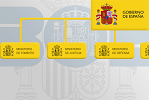What to do in the event of accidents in EU countries?
Content
Preliminary formalities at the site of the accident
The obligation to insure vehicles exists, as in all EU countries.
What is the Informative Records of Insured Vehicles?
Each country must have a system that is available to the victims of a road accident to allow them to identify the insurer of the other vehicle involved to which the victims can submit their claim. This identification may be made at the time of the accident or afterwards.
In Spain, the system is called the Informative Records of Insured Vehicles (FIVA) and it must contain:
- The data relating to all insured vehicles that are habitually parked in Spain.
- Their respective insurers that will assume the compulsory civil liability.
It is managed by the Consortium of Insurance Compensation (CCS).
The victims of road accidents and the insurers, on behalf of their clients, consult the CCS to request the identification of the insurer of the licence number of plate of the other vehicle involved in the accident, to which they will submit their statement or claim.
Furthermore, every day, the CCS sends the Directorate-General for Traffic (DGT) updated information of insured vehicle registrations and de-registrations provided by the insurers in order to identify, by comparison, those vehicles that are registered as insured with the DGT but not with the FIVA. This makes it easy to detect vehicles that fail to comply with the legal obligation of being insured.
In the event of an accident in an EU country
If the insurer of the vehicle causing the accident is not known, the victim can contact the CCS to request information relating to the insurance of the referred vehicle. As an Information Body in Spain, it will obtain said information from the Information Body of the country where the accident took place.
Form for claiming compensation
Each country has their own form for claiming compensation, but in all cases it is important to take a note of the following:
- All the information about the accident and the other person involved, the vehicle registration plate and insurer and the circumstances of the accident.
- It is advisable, but not mandatory, to fill out an accident statement at the site of the accident.
European accident statement or agreed statement of facts
The accident statement form that is normally provided by the insurer can be used.
There is a ‘European accident statement’, also known as an ‘Agreed statement of facts’ that will help you to quickly take note of the necessary information and facilitate the processing of the insurance compensation. It contains the necessary instructions about how to complete it.
Statements made using this ‘agreed statement of facts’ can now be submitted by mobile phone by downloading an app. Consult your insurer about how to do it and its advantages.
The minimum data that must be annotated is as follows:
- Place and date of the accident.
- Description of the accident.
- Information about possible injuries.
- Material damage.
- Witness and their names and contact data.
- And as much information as possible about the other party: licence plate, country, make and model of the vehicle, circumstances in which the accident occurred, insurer and policy number.
Along with the statement, it is advisable to present other supporting documents such as:
- Photos
- Witness statements
- Police report in the event that the police intervene
You must report the accident to your insurer, even if you do not intend to submit a statement to the company because you have not suffered damage.
Compensation claims
EU countries are governed by what is established in the Directives on compulsory civil liability insurance for motor vehicles, which means that the vehicle insurance will always cover third party civil liability in these countries.
If the accident took place in an EU country and the other vehicle was to blame, European legislation allows you to claim for damage:
- In your country and
- In the country where the accident took place.
To report an accident in the country of the accident, send it to the insurer of the person responsible for the accident.
EU legislation has established a system whereby the victims of an accident in an EU country other than the country of residence of the victim can report the accident when they return to their country and in their language. For this reason, if you want to wait until you return to Spain, you have two options:
- Send the report to the representative in Spain of the insurer of the party responsible for the accident in order to process the claim. To find out who the representative is and their address, contact the National Information Body, which, in the case of Spain, is the CCS.
- If the insurer of the other EU country has no representative in your country, even though this is required by law, or if you have not received a response from the representative within three months or the response has insufficient grounds, send your claim to the:
National compensation body, which, in the case of Spain, is OFESAUTO.![]()
This Body can also intervene if the other vehicle is not insured, or if it is impossible to determine the insurer.
Compensation amount
As for the limit of the compensation, in the event of an accident with a Spanish vehicle, the following limits will apply:
- Those foreseen in the EU Member State where the accident occurred, unless those limits are lower than those existing in Spain, in which case the Spanish limits will apply.
- In other words, the highest amount will always be applied or, in other words, EU legislation guarantees you will get the most beneficial cover.
If, on the contrary, the accident costs exceed such limits, the difference between what is covered by the compulsory vehicle insurance and what must eventually be compensated will be paid by the party responsible for the accident or their insurer if they have liability or third party damage cover above the compulsory limit.
Legal and/or technical references
-
Royal Legislative Decree 8/2004 of 29 October 2004 approving the recast text of the Law on civil liability and insurance for motor vehicles

-
Royal Legislative Decree 1507/2008 of 12 September 2008 approving the Regulation on compulsory civil liability insurance for motor vehicles

-
Directive 2009/103/EC of the European Parliament and of the Council of 16 September 2009, relating to insurance against civil liability in respect of the use of motor vehicles, and the enforcement of the obligation to insure against such liability

-
Royal Legislative Decree 7/2004 of 29 October 2004 approving the recast text of the Legal Statute of the Consortium of Insurance Compensation

-
Order EIC/764/2017 of 26 July 2017 laying down the rules governing the operation of the Spanish Motor Insurers Bureau











